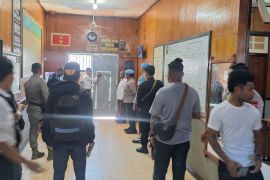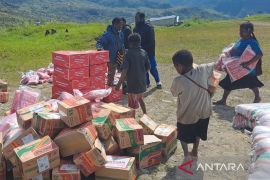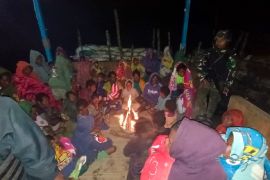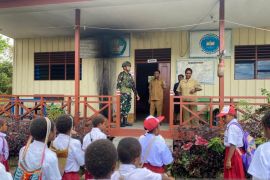The passing of the bills as laws demonstrated the government’s commitment to accelerating development in the Papua region.
After the laws are passed, the central government is subsequently tasked with establishing the provincial administration.
Currently, the central government continues to conceive policies and derivative laws for the three new Papuan provinces, including designating the new provincial governments and establishing the first provincial legislatures.
Apart from proposing the most suitable legal basis for the new provincial administration, the Home Affairs Ministry will also collaborate with relevant stakeholders to manage the provincial apparatus in the three new provinces, including implementing affirmative action for Papuan natives as state employees.
Prompt action to set up the provincial administrations is necessary, so that the new provinces will soon have in place a complete apparatus to start their work to fulfil obligations to serve the people.
One of the three new provinces for which the legal basis was recently finalised is Central Papua Province, with Nabire District, located north of the province, designated as the provincial capital.
Central Papua autonomy
Central Papua Province was carved up from the western part of Papua Province. The new province comprises eight districts: Nabire, Paniai, Mimika, Dogiyai, Intan Jaya, Deiyai, Puncak, and Puncak Jaya.
The province, to the north, is bordered by the districts of Waropen and Mamberamo Raya and Cenderawasih Bay, all in Papua Province.
The eastern part of the province borders the districts of Lanny Jaya, Nduga, and Tolikara, all within the newly established Papua Highland Province and Asmat District in the new South Papua Province.
As the Aru Sea forms the southern border of the province, the western part of the province is bordered by the districts of Kaimana and Teluk Wondama in West Papua Province.
Despite being carved out from the autonomous Papua province, Central Papua Province will not lose its special autonomy status, according to Law No. 2 of 2021 on Special Autonomy of Papua.
Law No. 2 of 2021 ensures special autonomy status for all provinces in the Papua region, including newly established provinces. The special autonomy status means that Papuan provinces are able to regulate the province according to the aspirations and customs of the Papuan people.
As the end of the New Order ushered the Reform Era, the House of Representatives and the president at that time concurred to awarding special autonomy status to the Papuan region following comprehensive research involving various stakeholders.
After the House of Representatives passed the Papuan autonomy bill as law in 2001, President Megawati Soekarnoputri signed Law No. 21 of 2001 on Special Autonomy for Papua Province on November 21 that year.
To bolster development in the Papua region, Soekarnoputri then enacted Presidential Decision No. 1 of 2003 that divided the region into two provinces: Papua and West Papua.
Some 19 years later, the government passed Law No. 2 of 2021 that amended the 2001 special autonomy law to perfect the autonomous status for provinces in Papua.
Central Papua and customary region
The establishment of new provinces in the Papua region is an implication of the decision to carve new provinces according to customary regions recognised by Papuan natives, according to Home Ministry’s Director of Special Autonomy Region Management Valentinus Sudarjanto Sumito.
The new province of Central Papua corresponds to the native Mee Pago customary region, where the Mee people live.
The Mee people are centred around Paniai, Tage and Tigi lakes, Kamu Valley (now in Dogiyai), and Mapiha/Mapisa Mountain, so the coast in the province’s south and mountain forms the geographic characteristics of the province.
The Mee people are known to possess high wisdom, critical and logical thinking, comprehension of their own community to differentiate themselves from other groups and are observant of the ancestors’ customs and rules.
According to the Statistics Indonesia (BPS) Population Census in 2020, Central Papua’s population reached 1,391,123 people, with the districts of Mimika, Paniai, and Puncak Jaya being the top three districts, with the most population in the new province.
In descending order, the population in Mimika District reaches 311,969 people, while Paniai has 220,410 people; Puncak Jaya recorded 224,527 people; Nabire’s population reaches 169,136 people; Intan Jaya, with 135,043 people; Dogiyai, with 116,206 people; Puncak, with 114,741 people; and Deiyai, with 99,091 people.
The BPS also projected population growth in districts that form the Central Papua Province to reach a total of 1,408,991 by 2021, with Mimika being the most populous district, yet Puncak Jaya overtook Paniai as the second most populous region.
In detail, the projected population in Mimika by 2021 was 316,295 people; 227,641 people in Puncak Jaya, and 223,467 people in Paniai. Furthermore, the projected population in Nabire was 170,914 people; Intan Jaya, 136,916 people; Dogiyai, 117,818 people; Puncak, 115,474 people, and Deiyai, 100,466 people.
Concrete and prompt actions to establish three new provinces in Papua is not the last effort the central government would take to bolster development in Papua.
The central government will also rev up efforts to establish a regional administration in the new provinces to ensure the new authority can promptly work for the people and realise the residents' aspirations.
Related news: Papua district heads support creation of Pegunungan Tengah province
Related news: Govt to consider issuing poll rules for new provinces
Editor: Rahmad Nasution
Copyright © ANTARA 2022












